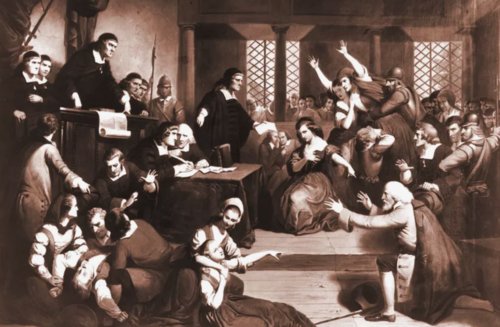

:max_bytes(150000):strip_icc():format(webp)/Trial-of-George-Jacobs-51246069X2-58b748dd5f9b58808053b32a.png)
In 17th century England and New England, it was believed that a "witch's cake" had the power to reveal whether witchcraft was afflicting a person with symptoms of illness. Such a cake or biscuit was made with rye flour and the urine of the afflicted person. The cake was then fed to a dog. If the dog exhibited the same symptoms as the ill person, the presence of witchcraft was "proven." Why a dog? A dog was believed to be a common familiar associated with the devil. The dog was then supposed to point to the witches who had afflicted the victim.
In Salem Village, in the Massachusetts colony, in 1692, such a witch's cake was key in the first accusations of witchcraft that led to court trials and executions of many who were accused. The practice was apparently a well-known folk practice in English culture of the time.
In Salem Village, Massachusetts, in January of 1692 (by the modern calendar), several girls began behaving erratically. One of these girls Elizabeth Parris, known as Betty, was nine years old at the time. She was the daughter of the Reverend Samuel Parris, the minister of the Salem Village Church. Another of the girls was Abigail Williams, who was 12 years old and an orphaned niece of Reverend Parris, who lived with the Parris family. The girls complained of fever and convulsions. The father tried prayer to help them, using the model of Cotton Mather, who had written about curing similar symptoms in another case. He also had the congregation and some other local clergy pray for the girls to cure their affliction. When prayer did not cure the illness, Reverend Parris brought in another minister, John Hale, and the local physician, William Griggs, who observed the symptoms in the girls and could find no physical cause. They suggested that witchcraft was involved.
A neighbor of the Parris family, Mary Sibley, recommended the making of a witch's cake to reveal whether witchcraft was involved. She gave directions to John Indian, an enslaved man serving the Parris family, to make the cake. He collected urine from the girls and then had Tituba, a woman also enslaved by the household, actually bake the witch's cake and feed it to the dog that lived in the Parris household. (Both Tituba and John Indian were brought to Massachusetts Bay Colony from Barbados and enslaved by Reverend Parris.)
Even though the attempted "diagnosis" revealed nothing, Reverend Parris denounced in church the use of this magic. He said it didn't matter if it had been done with good intentions, calling it "going to the devil for help against the devil." Mary Sibley, according to church records, was suspended from communion. Her good standing was restored when she confessed before the congregation, and the people of the congregation raised their hands to show they were satisfied with her confession. Mary Sibley then disappears from the records about the trials, though Tituba and the girls figure prominently.
The girls ended up naming those they accused of witchcraft. The first accused were Tituba and two local girls, Sarah Good and Sarah Osbourne. Sarah Osbourne later died in prison, and Sarah Good was executed in July. Tituba confessed to witchcraft, so she was exempted from execution, and she later turned accuser.
By the end of the trials early the following year, four accused witches had died in prison, one had been pressed to death, and 19 were hanged.
Scholars generally agree that the accusations were rooted in a community hysteria, primed by belief in the supernatural. Politics within the church likely played a part, with Reverend Parris at the center of a controversy regarding power and compensation. Politics in the colony likely also played a part: It was an unstable historical period. Some historians point to some long-standing squabbles among community members as some of the underlying problems that fueled the trials. All these factors are credited by many historians as playing a part in the unfolding of the accusations and trials. A few historians have also argued that grain that had been contaminated with a fungus called ergot may have caused some of the symptoms.
